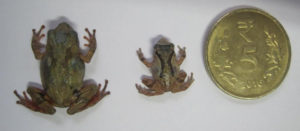By Bhaskar Saikia, Zoological Survey of India, Shillong
With the onset of pre-monsoon showers in Shillong, the city dwellers are kept awakened at night with a constant cacophony of ‘tick-tick-tick’ that can be heard from the nearby forests,  brooks, bushes and virtually from everywhere. While most people may confuse this sound as that of insects, but in reality, it belongs to a species of tiny bush frogs, which was discovered from Shillong in 1973. Interestingly, it is a Critically Endangered species besides being endemic to East Khasi Hills. The scientific name of this frog species is Raorchestes shillongensis and is commonly known as the Shillong Bush frog, because they are usually found in the forest bushes of Shillong.
brooks, bushes and virtually from everywhere. While most people may confuse this sound as that of insects, but in reality, it belongs to a species of tiny bush frogs, which was discovered from Shillong in 1973. Interestingly, it is a Critically Endangered species besides being endemic to East Khasi Hills. The scientific name of this frog species is Raorchestes shillongensis and is commonly known as the Shillong Bush frog, because they are usually found in the forest bushes of Shillong.
The frogs of this species is so tiny that a fully grown adult can sit on a coin yet with further space left for another frog! This makes Shillong Bush frog one of the smallest vertebrate species in the world!
The story of the discovery of this colourful frog species is intriguing. Scientists from the Zoological Survey of India (ZSI), Shillong chanced upon a number of frogs huddled in the soil from the nearby Malki forest where earth ‘cutting’ or forest shedding was underway making a “kutcha” forest road in 1971. As the frogs were examined, they were found to be unknown to science, and then was formally published in 1973 as a new species. Since then, a number research works have been carried out on this species such as their population status, distributions, morphological variations, breeding biology, by the scientists of ZSI and Wildlife Institute of India, Dehradun (WII).
Predominantly found on the forest bushes up to a height of two meters from the ground, but travel down to the ground to lay their eggs underneath leaf litters after which the female covers the eggs with moist soil, afterwhich they develop into froglets. Unlike the notion that all frog eggs hatch into tadpoles which later undergo metamorphosis to evole into frogs is incorrect. In the case of Shillong Bush frogs, the development is direct, and the froglets that hatch are miniature versions of the adult frogs. Biology is thus, regarded as the science of exception because living organisms show wide variations as a result of evolution, mutation and genetic re-combinations, and the bush frogs serve as a classic example of that.
The population of the Shillong Bush frogs is by and large restricted to Shillong and its suburbs, with pockets of populations known from Mawphlang, Kharang, Mawlyngot, Pynursla and Dain Thlein Falls areas – all located within East Khasi Hills district. This restricted distribution of this species makes it vulnerable to any degradation of its habitats, which justifies them being placed under the Critically Endangered category (species in grave danger of extinction) under the International Union for Conservation of Nature (IUCN) Redlist. IUCN, an international organisation that is engaged in the field of conservation and sustainable use of nature, also categories the threat categories of biodiversity. However, the high density of population (and its cacophony) of the Shillong Bush frog within the city and its suburbs witnessed especially during the monsoons, suggests that its population is stable and healthy. This is good news for all nature lovers that Shillong is home to such a fragile species, whose stable population bears testimony for the conducive environment of the city for wildlife. Nevertheless, this seemingly stable population does not mean that the Shillong Bush frog is not vulnerable to the pressures of extinction, as the city and its peripheral-urban areas have witnessed massive constructional activities, rising pollution of its water-bodies like Wah Umkhrah and Wah Umshyrpi, and a general trend in habitat degradation in recent years. These could spell doom for any species that is restricted to a small area of distribution, and especially to a perianthrophic species like the Shillong Bush frog.
What might still intrigue the readers is where do the seemingly thousands of bush frogs vanish during the winter and why do the forests, brooks and homesteads turn silent then. This is explained by the intrinsic nature of frogs being cold blooded species that undergo hibernation during the cold. When the ZSI scientists collected the frogs of this species for the first time in 1971, the month was February; they were hibernating in the soil during winters, as they change body colour to camouflage its surrounding.
Shillong has the epithet of being the Scotland of East. Now can we think of another moniker for Shillong to reflect it being an abode for a critically endangered animal species?



